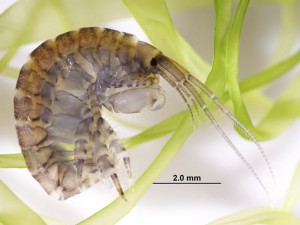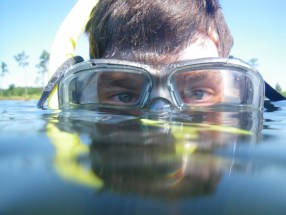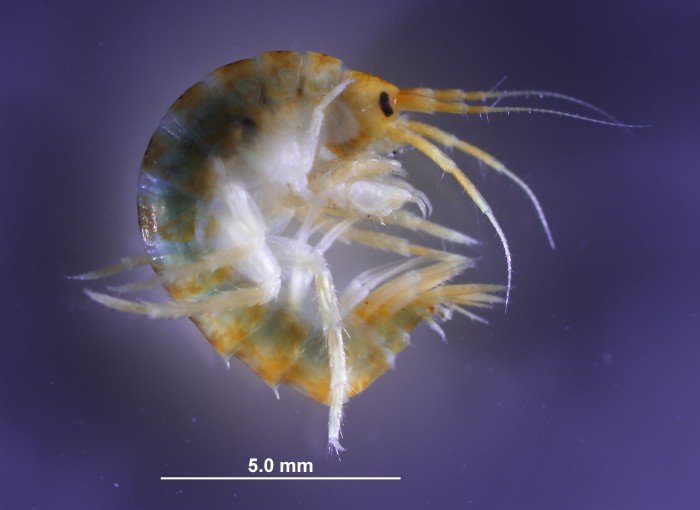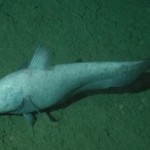
Source: Matt Whalen
Amphipods and I, well, we have a love/hate relationship. I love them because, for all intents and purposes, they are the rolly pollies of the ocean. And come on…who doesn’t love rolly pollies!?
However, when it comes to using these crusty critters in experiments, all that miniaturized cuteness goes completely out the window and I loathe them with a deep-seated passion. Why such a transition? Well, amphipods and many small invertebrates maintain certain attributes that tend to drive me, and, I am sure others, absolutely bonkers. For starters, there are a gazillion different kinds of them and they all look relatively similar. Not to mention, the only way you can tell most of them apart is with a microscope (though there are exceptions to this rule). Oh, and just to put the icing on the proverbial cake, they never seem to stay where you want them too. Real World Example: The other day I put ten amphipods in a bucket for safe keeping. I come back the next morning and three of them had mysteriously vanished. Poof. Gone. No trace. No goodbye letter. Nothing…except a heartbroken and rightly frustrated me.
Despite slight experimental downfalls, these tiny amphipods and their mesograzer brethren (other small invertebrates that feed on algae) are critically important links in many marine systems, especially when it comes to

seagrass habitats. But how does one accurately quantify their importance unless they can tame the savage beast?
You get yourself a one of a kind mesograzer wrangler. That’s how.
Luckily, I was able to find one and caught up with the crustacean cowboy himself, Matt Whalen, regarding his recent paper in Ecology. Wranglin’ Whalen and his seagrass posse over at the Virginia Institute of Marine Science are exploring how novel methods are giving us insights into just how important these mighty mesograzers are, and what other factors play a role in influencing seagrass communities.
Specifically, Whalen tested both the roles of nutrient addition and mesograzer grazing on their respective abilities to influence epiphytes. Epiphytes are a form of algae that can grow on seagrasses and compete with them for important resources such as light. The nutrients can increase epiphyte growth, whereas the mesograzers can keep it under control. However, such things are hard to test in a realistic field setting due to the qualms listed above (i.e. mesograzers don’t play nice). However, this was not the case for Wranglin’ Whalen.

Source: Matt Whalen
Using the insecticide Carbaryl, Whalen was able to completely exclude these mesograzers and thus able to test their effects on epiphytes. By removing them from plots, Whalen and his team were able to discover that these tiny little crustaceans, especially amphipods, are playing a significant role in noming those pesky epiphytes off of seagrass blades. Saving the seagrass and getting lunch to boot? Sounds like my kind of day.
Understanding these mutualistic interactions helps broaden our knowledge on how seagrass ecosystems are operating. Why do we care about seagrass? Well, from the Wrangler himself, “Healthy seagrasses perform many beneficial functions for humans, such as erosion control and providing refuge and hunting grounds for many fish species.” Moreover, seagrasses are critical nursery habitats for many species of commercially valuable little fish.
However, I believe Whalen explains the role of seagrasses as nursery habitats best, as not only is he a mesograzer wrangler, but he occasional plays the role of a scientific bard.
A Seagrass Haiku
By: Matt Whalen
“Small fish stay hidden
in arms reaching to the sun
undersea forest.”
Reference
Whalen, M.A., J.E. Duffy, and J.B. Grace. 2013. Temporal shifts in top-down vs. bottom-up control of epiphytic algae in a seagrass ecosystem. Ecology 94(2), 510-520.
(Note to friends and colleagues of Matt: I declare that from this day henceforth he shall forever be known as… Wranglin’ Whalen.)







Nerd-note: this paper is also a smokin’ hot example of how to use Structural Equation Modeling for Ecology. Just sayin’.
That Figure 4 is beastly….I don’t even think I can use something like that for my research…but I want it anyways…..
It’s not so bad. Just a hop skip and a jump from multiple regression kinds of techniques. With a twist of awesome.